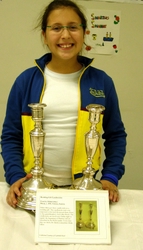 How to Select a Great Artifact How to Select a Great Artifact - The artifact tells something important about your family or a member of your family. Often when people save things for a long time, it is because these objects have special meaning for them. A cooking pot is an everyday object, but if you have a cooking pot that your great-grandmother used to make cholent (Sabbath stew) for her family in Poland and then in Cincinnati, then this pot tells story of how your great-grandmother took care of her family, both in Europe and the United States, and how, despite the move to a new country, she continued to maintain tradition.
- The artifact has been passed down through two or three generations. Something that originally belonged to your great-grandparents or your grandparents can be an interesting artifact. This kind of artifact has lasted longer and has a longer story to tell. If your great-grandparents escaped from Nazi Germany in 1938 and brought with them a small Kiddush cup, you can tell more stories about this cup than a Kiddush cup that you bought last week at a Judaica store.
- Durable objects work best. Extremely fragile items should be avoided because they might break on your trip to school. For example, A delicate crystal wine cup would not make a good artifact for the Living Museum project because of the high likelihood that it will be broken while being handled or photographed.
- Find an object that will photograph well. Avoid very small things (they may require a special camera setting or lens) and avoid things that are hard to identify just by looking at them (even though there will be a label next to each artifact image).
Do the Research! - Once you have selected an artifact, be sure to speak with your grandparents, parents, or other relatives about the artifact and its significance. Ask them why they kept it, and what story it tells.
- Click here for Interview Guidelines. Completing this form will help you gather the information you need. And, if other questions come up as you research your object, ask those questions as well.
- Your teacher and your family will help you research your artifact and complete the worksheet.
|
 How to Select a Great Artifact
How to Select a Great Artifact  How to Select a Great Artifact
How to Select a Great Artifact